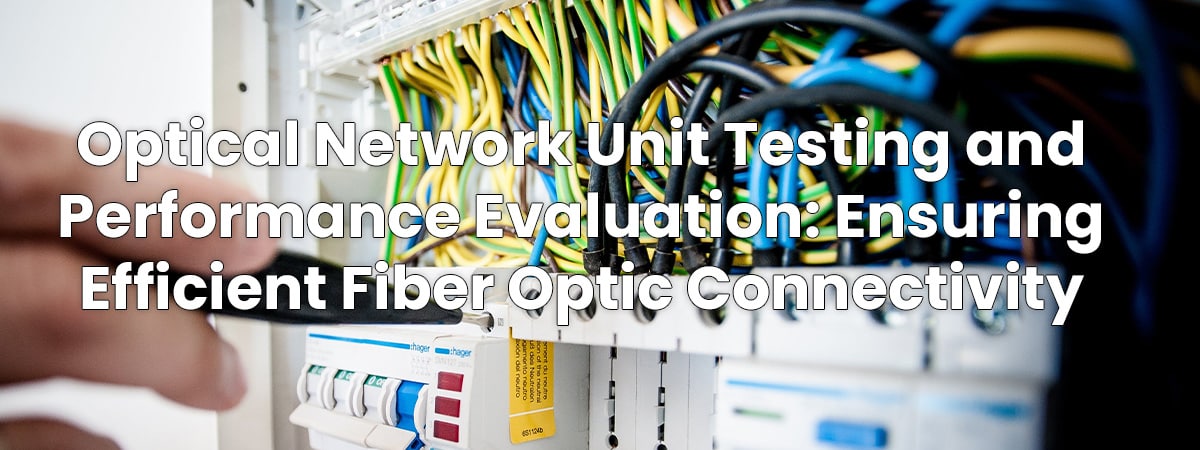Introduction:
In today’s digitally driven world, the demand for high-speed and reliable internet connectivity has never been greater. Fiber optic networks have emerged as a crucial infrastructure for delivering ultra-fast broadband services. At the heart of these networks, Optical Network Units (ONUs) play a pivotal role in connecting end-users to the optical backbone. To ensure optimal performance and uninterrupted service delivery, rigorous testing and performance evaluation of ONUs are essential. In this article, we delve into the intricacies of ONU testing and performance evaluation, highlighting their significance in maintaining efficient fiber optic connectivity.
The Importance of ONU Testing:
1.1 Ensuring Quality and Reliability: ONU testing validates the quality and reliability of fiber optic connections. By subjecting ONUs to comprehensive tests, network operators can identify and rectify any potential issues that may hamper the performance of the overall network.
1.2 Compliance with Industry Standards: Testing ONUs against established industry standards ensures adherence to performance benchmarks, security protocols, and compatibility requirements. Compliance assures customers of a standardized experience and fosters interoperability between network equipment from different vendors.
1.3 Diagnosing and Resolving Faults: ONU testing assists in diagnosing faults within the unit or the network. Identifying issues promptly allows network operators to implement appropriate measures to rectify them, reducing downtime and improving overall network reliability.
Key Testing Techniques for ONUs:
2.1 Power Level and Optical Loss Testing: Power level and optical loss measurements are crucial for verifying the signal strength and integrity of the optical link between the ONU and the Optical Line Terminal (OLT). These tests help identify any signal attenuation or abnormalities that may impact network performance.
2.2 Bit Error Rate Testing: Bit Error Rate (BER) testing evaluates the error rate of transmitted data, providing insights into the overall quality of the network link. By simulating real-world conditions and assessing error rates, network operators can optimize network configurations and improve data transmission reliability.
2.3 Throughput and Latency Testing: Throughput and latency tests assess the efficiency and responsiveness of data transmission within the network. Measuring throughput helps determine the network’s maximum data handling capacity, while latency tests evaluate the time taken for data to travel between the ONU and the OLT, ensuring minimal delays.
Performance Evaluation of ONUs:
3.1 Bandwidth Allocation and QoS: Performance evaluation involves assessing the ONU’s ability to allocate bandwidth effectively among connected end-users. Quality of Service (QoS) parameters, such as packet loss, latency, and jitter, are measured to ensure that network resources are efficiently distributed, guaranteeing a seamless user experience.
3.2 Scalability and Future Readiness: Evaluating an ONU’s scalability is crucial to accommodate future network expansion and increasing user demands. By assessing the unit’s capability to handle a growing number of subscribers and higher data rates, network operators can plan for network upgrades proactively.
3.3 Security and Data Protection: Performance evaluation includes verifying the ONU’s security features, and ensuring the protection of user data and privacy. Evaluating encryption protocols, access controls, and intrusion detection systems help fortify the network against potential threats and vulnerabilities.
Conclusion:
Optical Network Unit Testing and Performance Evaluation are fundamental processes for maintaining efficient fiber optic connectivity. By subjecting ONUs to rigorous testing techniques and evaluating their performance, network operators can guarantee the quality, reliability, and security of their fiber optic networks. These measures result in enhanced customer satisfaction, reduced downtime, and improved overall network performance. Embracing comprehensive ONU testing and performance evaluation practices is crucial for meeting the ever-increasing demand for high-speed, reliable internet connectivity in today’s digital landscape.
